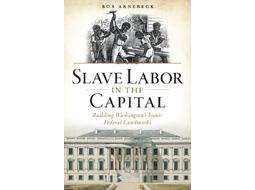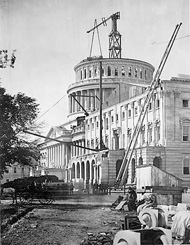A Look at the DAR Library Lecture Series: Bob Arnebeck's Slave Labor in the Capital

On October 31, 2015, the patrons attending the DAR Library’s James C. Thompson Lecture were given a real treat as Mr. Thompson brought us all back in time to Colonial Virginia. More specifically he brought us the story of William “Billy” Lee by going back through complex family genealogies, and then transitioning into portrayals of Billy Lee by different artists over time. It was a fascinating story about one of America’s most famous and most mysterious African American men. If you missed this lecture, we also had the pleasure of welcoming C-SPAN3 in to tape the lecture. Keep an eye out for more information about when the lecture will air. Tune in to see a great explanation of who Billy Lee could have really been.
 Saturday, December 5, 2015, is not just the day to leave your shoes out for some early treats from Old Saint Nick, but also the day the DAR Library welcomes author Bob Arnebeck, who will be speaking on his work Slave Labor in the Capital: Building Washington’s Iconic Federal Landmarks. Article 1, Section 8 of the U.S. Constitution gave the Congress power to select a district no more than 10 square miles to designate as the Capital of the United States. In 1790, Congress authorized President George Washington to place this Capital in parts of Maryland and Virginia along the Potomac River, nearby to where the President lived and grew up. By 1791 the wheels to build this new Capital started turning. A commission of three men was chosen. All three men were either former associates or related to the President. Two of them had grown up in the South, where slavery was much more prevalent than in the Northern states. An early solution they developed to keep costs low for building the U.S. Capitol and the White House was to hire slaves from far off Maryland plantations to do a good share of the unskilled labor, while also hiring free black men, and Irish and Scottish immigrants.
Saturday, December 5, 2015, is not just the day to leave your shoes out for some early treats from Old Saint Nick, but also the day the DAR Library welcomes author Bob Arnebeck, who will be speaking on his work Slave Labor in the Capital: Building Washington’s Iconic Federal Landmarks. Article 1, Section 8 of the U.S. Constitution gave the Congress power to select a district no more than 10 square miles to designate as the Capital of the United States. In 1790, Congress authorized President George Washington to place this Capital in parts of Maryland and Virginia along the Potomac River, nearby to where the President lived and grew up. By 1791 the wheels to build this new Capital started turning. A commission of three men was chosen. All three men were either former associates or related to the President. Two of them had grown up in the South, where slavery was much more prevalent than in the Northern states. An early solution they developed to keep costs low for building the U.S. Capitol and the White House was to hire slaves from far off Maryland plantations to do a good share of the unskilled labor, while also hiring free black men, and Irish and Scottish immigrants.
Bob Arnebeck gives the reader a supremely fascinating look at the birth of the nation’s Capital. Arnebeck diligently did his research in order to weave together a narrative of the slaves, freemen, and immigrant workers who built the enduring symbols of freedom and liberty. Without all of the labor these men provided Washington, DC would not have been cleared of lumber, for it was a forest at first. It would not have developed roads, or lots of land that early residents could build their homes on. It certainly would not have the grandeur of the two buildings most associated with America’s glory, the U. S. Capitol and the White House. Ironically, as Arnebeck shows from the records of the Commissioners and letters from the men who built the Capital, enslaved men and women were the ones who originally built brick by brick, stone by stone, tree to lumber to wooden planks, the glorious buildings that still stand today.


 Today's DAR
Today's DAR